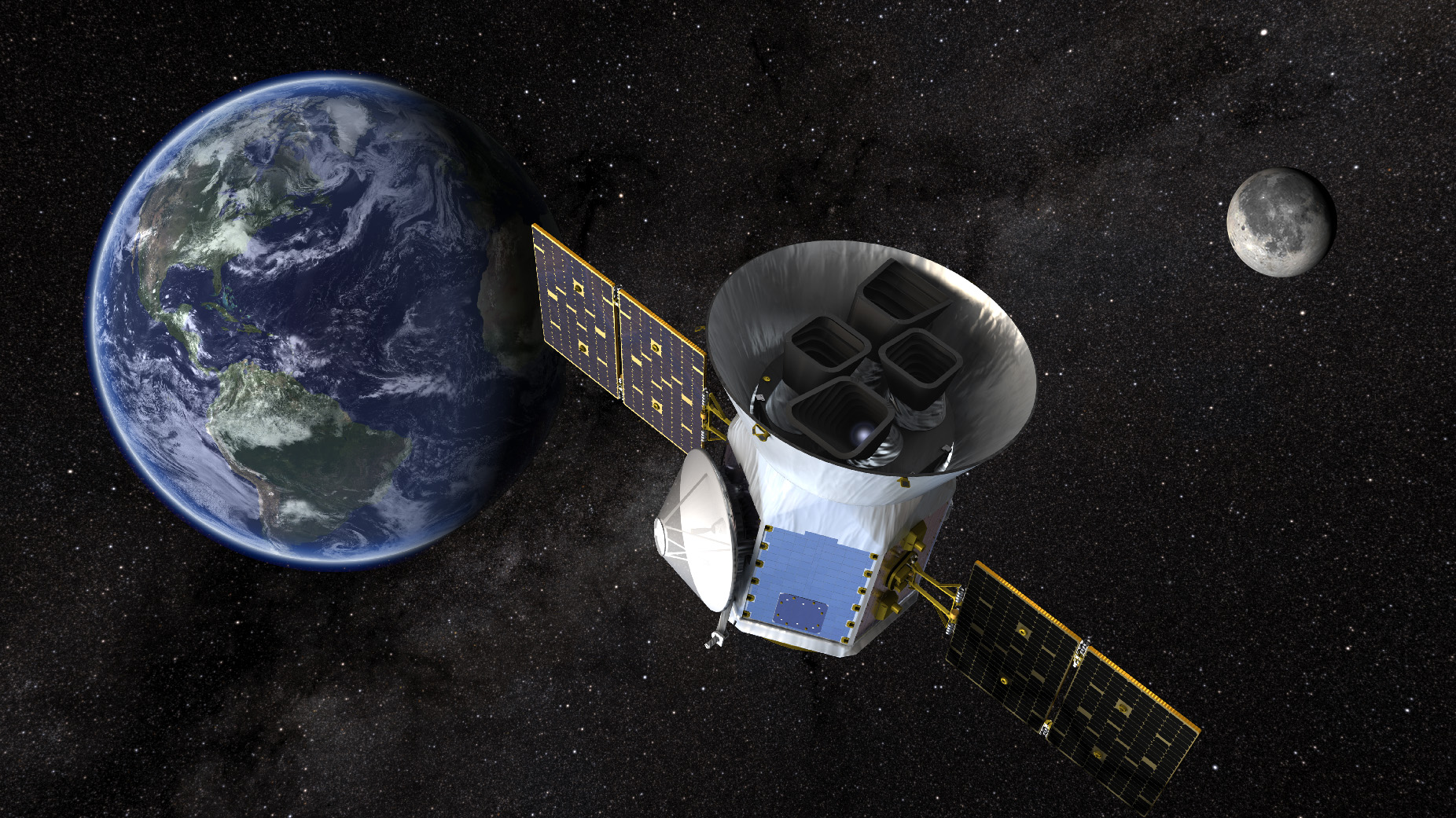NASA's TESS exoplanet-hunting satellite celebrates 5 years in space
NASA is blowing out the birthday candles as its TESS explorer marks five years of discovery.

NASA's Transiting Exoplanet Survey Satellite, or TESS, is now in its fifth year scanning the sky for new worlds.
Since its launch on April 18, 2018, TESS has mapped over 93% of the sky from its orbit around Earth, and in that time has produced 329 exoplanet confirmations and thousands more candidates.
Exoplanets are planets orbiting a star outside our own solar system. In order to find these worlds, four different cameras aboard TESS monitor specific sectors of space to measure changes in light around distant stars. When TESS first began its mission, the spacecraft captured such images at a rate of about one every half hour. According to NASA, mission operators have increased the probe's efficiency over the past five years to now handle a new image every 200 seconds.
Related: 9 alien planet discoveries that were out of this world in 2022
From these images, scientists at NASA's Goddard Space Flight Center are able to track the change in brightness of different stars. When an exoplanet crosses the face of its host star from TESS' perspective, the light from that star dims slightly. The TESS team is able to measure that change in light to spot exoplanets and determine how big it is. Follow-up work by other instruments on the ground and in space can characterize such worlds further — figuring out their mass, for example, or their rough atmospheric composition.
Some planets, like Earth, reside at just the right distance from their stars for water to exist as a liquid, rather than frozen solid or completely evaporated. Scientists refer to this as a star's habitable zone and often search for planets there in the hopes of discovering signs of life.
An exoplanet designated TOI 700 d was the first habitable-zone planet discovered by TESS. In January of this year, as the fifth anniversary approached, TESS discovered another planet in the same star's habitable zone, designated TOI 700 e.
Get the Space.com Newsletter
Breaking space news, the latest updates on rocket launches, skywatching events and more!
From the first discoveries by TESS to its most recent, the probe has played a tremendous role in mapping the cosmos. During its mission, TESS has also contributed in collaboration with other spacecraft to discover a trove of new cosmic phenomena, including NASA's Swift, NuSTAR and Spitzer Space Telescopes, as well as the European Space Agency's (ESA) XMM-Newton satellite.
"We have more than 251 terabytes just for one of the main data products, called full-frame images. That's the equivalent of streaming 167,000 movies in full HD," said mission project scientist Knicole Colón in a NASA statement.
"We're celebrating TESS's fifth anniversary at work — and wishing it many happy returns!" Colón added.
Follow us on Twitter @Spacedotcom and on Facebook.
Join our Space Forums to keep talking space on the latest missions, night sky and more! And if you have a news tip, correction or comment, let us know at: community@space.com.

Josh Dinner is the Staff Writer for Spaceflight at Space.com. He is a writer and photographer with a passion for science and space exploration, and has been working the space beat since 2016. Josh has covered the evolution of NASA's commercial spaceflight partnerships and crewed missions from the Space Coast, as well as NASA science missions and more. He also enjoys building 1:144-scale model rockets and human-flown spacecraft. Find some of Josh's launch photography on Instagram and his website, and follow him on X, where he mostly posts in haiku.
-
rod https://exoplanetarchive.ipac.caltech.edu/index.htmlReply
showing 330 TESS exoplanets now as confirmed. Nice job :) -
rod The 330 reported many are still very large exoplanets. Mean = 0.82 Mjup using all the rows reported for TESS. Min is 0.011 Mjup, max is 18.5. Mean radius earth radii = 5.86, min = 0.696, max = 9.937 earth radii size.Reply -
Dave Happy birthday TESS! Thanks to the analysis of missions like TESS and Kepler we understand planetary systems in our galaxy. Our knowledge of exoplanets has increased tenfold. And still, we have only seen the tip of the iceberg. These missions only see a small fraction of the exoplanets out there. Only a planetary system with a plane that lines up with our own can be seen. It is exciting. We have barely scratched the surface about our knowledge concerning exoplanets!Reply -
rod FYI. The NASA archive site allows downloading of just the TESS group, showing single row entries for values vs. multiple rows when you download and work with the entire lot :). I checked that for the 330 listed.Reply
Planet equilibrium temperatures are hot. Average 998K, min 163, and max 3646 K with 1sigma 512/513 K. This makes sense considering the tight orbits reported for TESS exoplanets confirmed. The average a = 0.088 au, min = 0.00622 au, max = 0.90281 au. 1sigma = 0.1131 au. Most are packed in tight to their parent stars. -
rod Here is another report from TESS, two exoplanets in their habitable zones but as I calculate, deep gravity well exoplanets too.Reply
Astronomers discover two super-Earths orbiting nearby star, https://phys.org/news/2023-05-astronomers-super-earths-orbiting-nearby-star.html
Ref - Two super-Earths at the edge of the habitable zone of the nearby M dwarf TOI-2095, https://arxiv.org/abs/2304.09220, 18-April-2023.
My note. Using the mass and radius of TOI-2095 b, gravity relative to Earth = 2.6234E+00, escape velocity = 20.24874296 km/s. The exoplanet has a deep gravity well and mean density about 1.1538E+01 g cm^-3.
My notes. Using properties for TOI-2095 c, this is another deep gravity well exoplanet reported. Radius = 1.33 rearth, mass = 7.4 mearth. Surface gravity = 4.1825E+00 or 4 g compared to Earth's 1 g. Escape velocity = 26.37249295 km/s, mean density = 1.7289E+01 g cm^-3.









